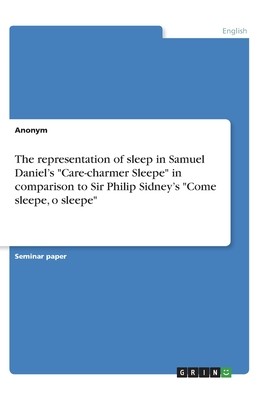
- We will send in 10–14 business days.
- Author: Anonym
- Publisher: GRIN Verlag
- Year: 2019
- Pages: 20
- ISBN-10: 366899384X
- ISBN-13: 9783668993846
- Format: 14 x 21.6 x 0.1 cm, minkšti viršeliai
- Language: English
- SAVE -10% with code: EXTRA
The representation of sleep in Samuel Daniel's Care-charmer Sleepe in comparison to Sir Philip Sidney's Come sleepe, o sleepe (e-book) (used book) | bookbook.eu
Reviews
Description
Seminar paper from the year 2018 in the subject English Language and Literature Studies - Literature, grade: 2,0, Christian-Albrechts-University of Kiel, language: English, abstract: Sleep is a prevalent motif in poetry. As a universal topic, sleep - or sleeplessness - has an impact on everyone.1 For this reason, many poets not only of the Renaissance dedicated the sonnets to their beloved to sleep. The aim of this seminar paper is to make transparent, how sleep is depicted in two different Renaissance sonnets. The sequence of sonnets to Delia by Samuel Daniel contains the poem Care-charmer Sleepe. Another poem, Come sleepe, o sleepe from the sequence Astrophil and Stella by Sir Philip Sidney, is also concerned with this topic. For this seminar paper, it is of great interest to examine in how far the illustrations of sleep in these two poems differ from each other or reveal similarities. This subject is of particular significance, as the two sonnet sequences have been written in about the same time, in the end of the sixteenth century, so that a comparison of the depictions of sleep is profitable. In the beginning, Sir Philip Sidney's sonnet is presented and investigated with regard to its depiction of sleep. The different techniques of figuration to achieve the illustration of sleep in the way the poem presents it are taken into account. Therefore, it will be revealed by which means sleep is pictured in this specific sonnet. Subsequently, the second poem by Samuel Daniel is looked at. It will be focused on the approach which the speaker in this sonnet takes to depict an image of sleep. By means of this, different aspects of illustrating sleep and techniques of achieving the result which is presented in the sonnets are emphasized and can therefore be compared in a following chapter. Research literature related to sleep as a motif in poetry and especially with regard to the two selected poems is rare. The field of research is a rather unexamined realm. Therefore,
EXTRA 10 % discount with code: EXTRA
The promotion ends in 22d.16:46:45
The discount code is valid when purchasing from 10 €. Discounts do not stack.
- Author: Anonym
- Publisher: GRIN Verlag
- Year: 2019
- Pages: 20
- ISBN-10: 366899384X
- ISBN-13: 9783668993846
- Format: 14 x 21.6 x 0.1 cm, minkšti viršeliai
- Language: English English
Seminar paper from the year 2018 in the subject English Language and Literature Studies - Literature, grade: 2,0, Christian-Albrechts-University of Kiel, language: English, abstract: Sleep is a prevalent motif in poetry. As a universal topic, sleep - or sleeplessness - has an impact on everyone.1 For this reason, many poets not only of the Renaissance dedicated the sonnets to their beloved to sleep. The aim of this seminar paper is to make transparent, how sleep is depicted in two different Renaissance sonnets. The sequence of sonnets to Delia by Samuel Daniel contains the poem Care-charmer Sleepe. Another poem, Come sleepe, o sleepe from the sequence Astrophil and Stella by Sir Philip Sidney, is also concerned with this topic. For this seminar paper, it is of great interest to examine in how far the illustrations of sleep in these two poems differ from each other or reveal similarities. This subject is of particular significance, as the two sonnet sequences have been written in about the same time, in the end of the sixteenth century, so that a comparison of the depictions of sleep is profitable. In the beginning, Sir Philip Sidney's sonnet is presented and investigated with regard to its depiction of sleep. The different techniques of figuration to achieve the illustration of sleep in the way the poem presents it are taken into account. Therefore, it will be revealed by which means sleep is pictured in this specific sonnet. Subsequently, the second poem by Samuel Daniel is looked at. It will be focused on the approach which the speaker in this sonnet takes to depict an image of sleep. By means of this, different aspects of illustrating sleep and techniques of achieving the result which is presented in the sonnets are emphasized and can therefore be compared in a following chapter. Research literature related to sleep as a motif in poetry and especially with regard to the two selected poems is rare. The field of research is a rather unexamined realm. Therefore,


Reviews